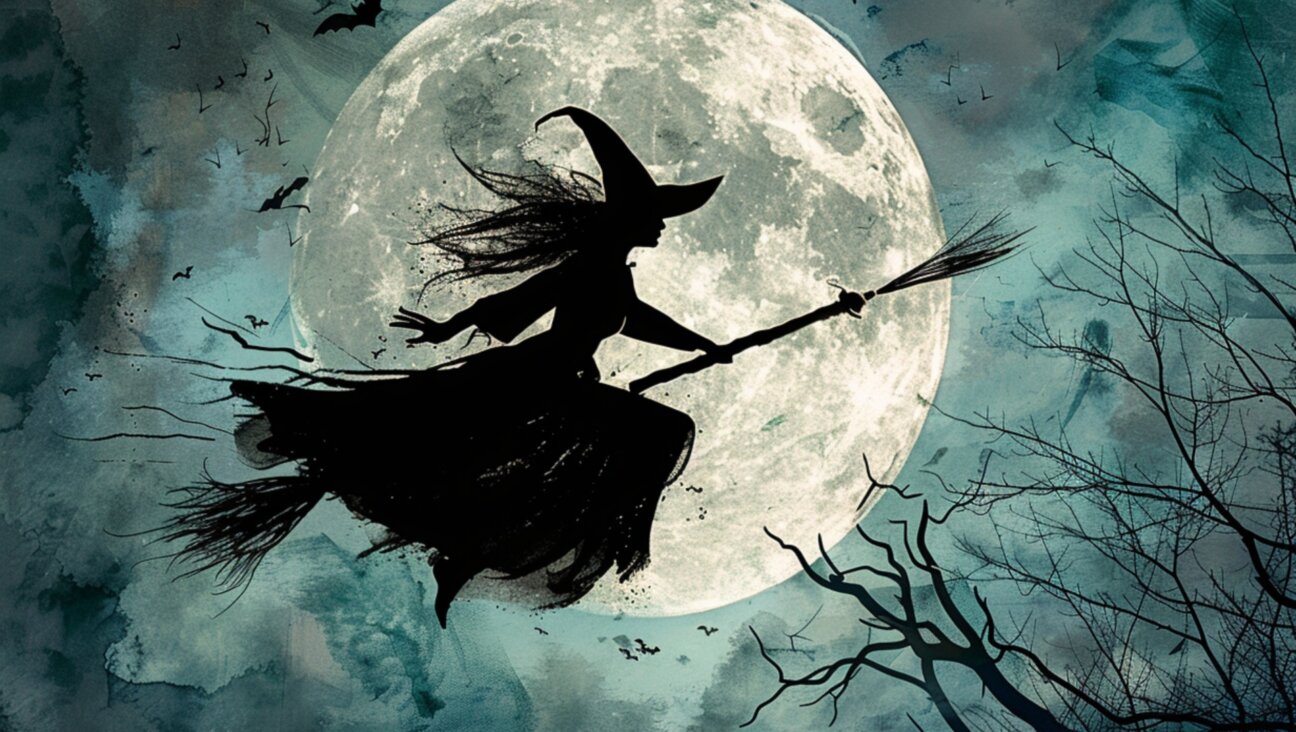How an elite group of Jewish refugees helped to defeat the Third Reich
X Troop played a crucial role in the D-Day landings and killed, captured and interrogated their way across occupied Europe all the way into the heart of the Third Reich

Graphic by Angelie Zaslavsky
Lieutenant George Lane is in big trouble. His waterlogged Sten gun has jammed, and bullets from German rifles and MP40s are flying all around him. He is hiding in the surf next to beach obstacles made of thin iron girders. The Nazis are shooting blindly into the darkness while Lane and Captain Roy Wooldridge, an expert in mines, desperately seek cover. It’s May 17, 1944, Ault, northern France, two hours after midnight, three weeks before D-Day.
Something has spooked the Germans, and Lane doesn’t know whether they have been discovered and the mission compromised, or the bored guards are now simply letting off steam. He does know that if they are taken prisoner, it will mean almost certain death. Adolf Hitler’s 1942 Kommandobefehl edict states that all captured Allied commandos are to be summarily executed. The two men lie as still as possible on the beach, and after 10 minutes the shooting stops. The British officers find their concealed rubber dinghy, which is miraculously unpunctured. They jump in, push into the waves and start paddling out to sea, hoping to make it back to the motor torpedo boat from which they deployed.
They begin to think that they might just make it back from this mission, but after rowing frantically for 20 minutes, they are spotted by a German E-boat. A blinding spotlight turns on them, and a 37 mm flak cannon and machine guns are pointed at their torsos. “Hände hoch, Tommy!” a Kriegsmarine lieutenant shouts.
Lane and Wooldridge have no choice but to surrender. Lane is thinking more about torture than the Kommandobefehl and summary execution. “The Gestapo make everyone talk,” he has been told.

The Titular Troop: X-Troop at Aberdovey, 1943 Courtesy of Leah Garrett
Lane is not worried about giving up any details about D-Day. As a lowly lieutenant he’s not privy to such operational information. He is concerned that the Germans will crack his cover story. And if they crack that, they might find out about his brother soldiers and their secret unit: X Troop.
The E-boat takes them ashore. Still in soaking-wet clothes, the prisoners are driven to a command post and put in two separate basement cells for a long, cold, hungry night. Desperate to escape from a likely firing squad, Lane manages to pick his door’s lock with a piece of metal ripped from a floor pipe. As he steps out into the dark corridor, a guard yells at him to get back into his cell.
The next morning Lane and Wooldridge are driven to a village in the French countryside. They are wearing blindfolds, but Lane’s has been fitted poorly and he is able to make a mental map of his bearings. They arrive at a place on the Seine River called Château de La Roche-Guyon, which has been turned into a Wehrmacht headquarters for Field Marshal Erwin Rommel. Rommel has chosen this spot because it lies neatly at the boundary between his two armies.
The British officers are separated. A German captain offers Lane something to drink and tells him that he should tidy himself up.
Lane asks why.
“Because you’re going to be interrogated by someone important,” the German explains.
Lane washes his face, cleans his fingernails, and is led into a study.
There is a man at the fireplace with his back to him. He turns. Lane is stunned to discover that it is Field Marshal Rommel himself. Lane instinctively gives him the salute due a superior officer. It’s an odd moment. Lane, like all the members of X Troop, is a fanatical anti-Nazi. His unit of Jewish commandos has been mostly recruited from German and Austrian escapees of the Nazi regime.

A Formidable Adversary: Erwin Rommel encountered X-Trooper Lieutenant George Lane. By Getty Images
This ragtag group includes a semiprofessional boxer; an Olympic water polo player; a previously Orthodox Jew obsessed with science; and painters, poets, athletes and musicians. By this stage of the war, the summer of 1944, most of their relatives who weren’t able to escape have been murdered in the death camps. To protect themselves and any family members still alive, the men in X Troop have all taken on fake English names and identities. Lieutenant George Lane himself is Lanyi György from Budapest, pretending to be a Welsh infantry officer. He’s lived in England for the past eight years; his English isn’t bad, but his Welsh accent is terrible.
“You realize that you are in a very tricky situation here, Lieutenant Lane?” Field Marshal Rommel says through an interpreter.
“I don’t think so. I happen to be a POW — there’s nothing tricky about that,” Lane responds.
“Well, my people seem to think that you are a common saboteur,” Rommel says.
“If the field marshal believed I was a common saboteur then I don’t think he would have invited me for tea,” Lane replies.
“So you think this is a polite invitation?”
“Indeed I do and I’m greatly honored by it,” Lane answers, to a smile from the field marshal. The ice has been broken.
Rommel’s adjutant pours the tea.
“So how is my friend General Montgomery?” Rommel asks.
“Unfortunately I don’t know him personally, but as you know he’s preparing the invasion, so I imagine you’ll see him very soon,” Lane says.
Rommel asks Lane where he thinks the invasion might be. Lane explains that he is only a junior officer who is not privy to any of the invasion plans.
Rommel nods. “Of course what you don’t realize is that the greatest tragedy today is that you British and we Germans are not fighting side by side against the real enemy, Russia.”
Lane knows he should keep his mouth shut, but he can’t help himself and he says, “Sir, how can the British and Germans fight side by side considering what we know about what the Nazis are doing to the Jews? No Englishman could ever tolerate such a thing.”
“Well, that’s a political argument, and as a soldier you shouldn’t be interested in politics at all,” Rommel answers curtly.
“I’m sorry, sir, but it’s very important to us English,” replies the Jewish refugee from Budapest.
The conversation peters out. A side door opens and an officer leads Lane away. Lane wonders what Captain Wooldridge will say during his interrogation. He’s furious with himself, knowing that he should have stuck to name, rank and serial number, but he hadn’t expected to see Field Marshal Rommel himself.
Lane is given a bite to eat and later that afternoon is handed over to the Wehrmacht — not, he is relieved to find, the Gestapo or the SS.
He is transferred to a prisoner of war camp, where he is released into the general population of POWs. His Welsh cover story doesn’t survive one day in the camp, and the English prisoners assume he is a stooge. He finds the camp’s Allied commanding officer and explains to him that he isn’t George Lane.
“Who the devil are you, then?” the commanding officer demands.
“I’m a member of X Troop.”
“And what the blazes is that?”
“Sit down, sir,” Lane says, “and I will explain everything.”
X-Troop: The Allies’ Secret Weapon
At the nadir of World War II, in Britain’s darkest hour, a group of Jewish refugees from Germany, Austria and Hungary volunteered for a top secret mission to fight as commandos on the front lines against the Nazis. Determined to wreak havoc on Hitler’s regime, the 87 men of No. 10 (Inter-Allied) Commando, 3 Troop — better known as X Troop — saw the war as personal. They played a crucial role in the D-Day landings and killed, captured, and interrogated their way across occupied Europe all the way into the heart of the Third Reich.

Walcheren, 1944: Maurice Latimer, on right, with captured prisoners from the Westkapelle lighthouse. Courtesy of Leah Garrett
To uncover the history of this remarkable unit, I declassified long-sealed, top secret British military records; read the breathless heat-of-the-battle official war diaries; and discovered a trove of startling new materials from the families of the X Troopers. I also conducted interviews with still-living commandos and the wives and children of a number of X Troopers. It is a tale that needed telling. This group of highly trained soldiers gained a fearsome reputation, and they found themselves fighting in France, Sicily, mainland Italy, Greece, Yugoslavia, Albania, the Netherlands and Belgium. When the war was over and most of their comrades were going home, these extraordinary men went hunting for Nazis in the rubble of Hitler’s Europe.
As Britain in 1942 sought to claw its way back from the brink of defeat and contemplated the daunting prospect of invading the Nazi-occupied European continent, British military planners determined they would need one weapon that was not yet in their arsenal: highly-intelligent, highly-motivated, German-speaking commandos. They would use these men to infiltrate behind enemy lines, interrogate prisoners on the spot, and help guide the Allied dagger into the heart of the Third Reich. To fill this role, the British conceived of X Troop, a unique commando force with an unusual combination of skills that usually don’t go together: advanced fighting techniques and counterintelligence training. These men had to be special. They had to be heart and head. They had to be both brains and brawn.
Only one group fit the bill: the German-speaking Jewish refugees who had been arriving in Britain since Hitler’s rise to power. Most of these “enemy aliens” came to England without their parents on Kindertransport trains or as part of religious missions. Many had lost their families, their homes, their whole worlds to the Nazis. They became one of Britain’s most important secret commando units, referred to by Miriam Rothschild, the famous spouse of one particularly storied X Trooper, as a “suicide squad.” The anger and hunger for revenge of these commandos was palpable.
Many were brilliant young men, sons of diplomats and scientists, but initially the British didn’t trust them because they were German, Austrian or Hungarian. So they put them in detention camps, often in appalling conditions. Eventually, though, the men were selected or volunteered for unspecified “hazardous duty,” which they were told would entail extremely dangerous work that involved taking the fight directly to the Nazis. Every man offered a place in X Troop accepted the mission.
In order to operate behind enemy lines they had to shed their previous lives as refugees and take on new British identities. If they were recognized as Jews, they would be killed instantly and the Gestapo would hunt down their families if they were still alive. Each volunteer was given a few minutes to pick a new British persona, then they had to destroy any connection with their old selves, burning letters from home and throwing out any belongings with their names on them. For those killed in battle this change would remain permanent, and many would be buried under their nom de guerre and a marble cross. Once they had their new names and identities, the X Troopers underwent tough commando training in Wales and Scotland. They spent days and nights hiking over mountains with full packs, and practiced beach assaults, live ammo drills, rock climbing, parachuting, and demolition work.

I.D. George Lane’s POW identity card issued after the Tarbrush 10 raid of May 1944. Courtesy of Leah Garrett
When their training was completed, the X Troopers became the very tip of the Allied spear, using their advanced fighting techniques to capture enemy soldiers and then immediately interrogate them rather than wasting valuable time bringing them back to headquarters. Where are the mines laid? How many soldiers are in your formation? What units are they from? Where is your headquarters? What weapons are being used? This information was used to make crucial battlefield decisions in the next minutes, hours, and days.
During their service the X Troopers worked with some of the most eccentric, brilliant characters of World War Two: Lord Lovat of the Special Service Brigade, Queen Victoria’s great-grandson Lord Mountbatten, Field Marshal Bernard Montgomery, and the famous Captain “Mad Jack” Churchill. They proved their worth again and again. And even after the war was over and the unit was formally disbanded, the X Troopers were central to the denazification campaign: routing out hidden party members (almost capturing the head of the SS, Heinrich Himmler), uncovering sensitive intelligence, and gathering evidence for the Nuremberg trials. At least 87 volunteers passed through the ranks of this elite unit, and half of them would be killed, wounded, or disappear without a trace. Collectively, the survivors and the fallen alike would contribute to the Allied war effort in a way that defies the imagination and that still has not received due credit.
Each member of X Troop has an exceptional biography, a tale of loss and redemption, of agency stolen and reclaimed. In the words of the commando Peter Masters, “Shocked by history, desperate, and in danger, we were threatened by Hitler … the creator of hell on earth, and we fought for the chance to counter those seemingly insurmountable odds.” Some of the men were more blunt about their motivations. One of Peter’s comrades later said, “Frankly I was looking forward to all the killing.” In this book I focus on three of these men in particular: Peter Masters (birth name: Peter Arany), Manfred Gans (nom de guerre: Fred Gray), and Colin Anson (birth name: Claus Ascher), whose stories are typical of the others’. I also looked in some detail at the men who fought under the names George Lane, Ian Harris, Tony Firth, Maurice Latimer, Geoff Broadman, Ron Gilbert, and Paul Streeten.
As of 2021 several military and intelligence files relating to X Troop still remain classified. Until these secret files are fully available to the public, however, the history of this unit will remain somewhat cloaked in shadows — much like the commandos themselves. The X Troopers’ aliases also present a challenge to any historian, especially one who aims to tell their individual stories from beginning to end.

Chronicler of a Forgotten History: Leah Garrett is the author of “X Troop: The Secret Jewish Commandos of World War II” By Deb Caponera
Many of the men chose to keep their cover identities after the war, living out their lives under the names not of the refugees they had been, but of the soldiers they had become. This also reflects a broader truth about this remarkable group of soldiers: After enduring unspeakable abuse at the hands of a genocidal, totalitarian state, the X Troopers became masters of their own fate, winning a personal victory. Their story is a remarkable testament to the human ability to face the most extreme challenges while staying focused on a higher goal: in this case, to right a world that had gone terribly awry.
Excerpt from “X Troop: The Secret Jewish Commandos of World War II” by Leah Garrett. Copyright © 2021 by Leah Garrett. Reprinted by permission of HMH Books & Media

















